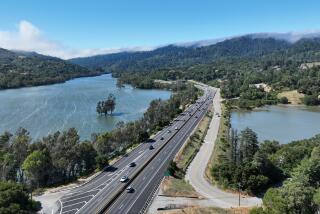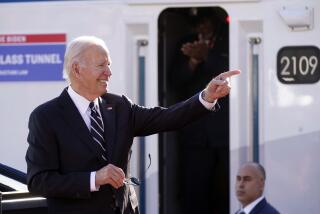Mountains Don’t Intimidate Today’s Road Builders
- Share via
PIKEVILLE, Ky. — When road crews first built U.S. 119 through eastern Kentucky, they treated Pine Mountain like the neighborhood bully, treading gingerly around the steep slopes.
No more Mr. Nice Guy.
The next road will go straight through the heart of the mountain, creating one of the longest vehicle tunnels in the United States.
The Appalachian Regional Commission, charged by Congress to build roads to open the mountain region to economic progress, is also taking on several other mountains that have stood defiantly in the way.
The commission plans to spend $6.8 billion over 20 years to build 500 miles of modern roads into the most isolated areas of Appalachia. Thirteen states will contribute an additional $2 billion to the effort.
“You’re facing mountain ridges everywhere you look,” said Kevin Damron, a highway planner for the Kentucky Transportation Cabinet. “It’s very rugged terrain.”
With crews pushing through six mountains to build U.S. 119 in eastern Pike County, Damron said the cost has reached $20 million a mile.
The cost is even higher -- $30 million a mile -- on an 18-mile stretch of U.S. 460 near Elkhorn City, near the Virginia border, because of the additional expense of cutting into mountaintop and bridging hollows.
Jesse L. White Jr., co-chairman of the commission, said the roads that were promised to the people of Appalachia must be completed.
“It’s not a partial promise,” he said. “It’s essential that the entire system be completed, and I am confident it will be.”
Still, local officials who have waited and watched as roads were built in other parts of the region worry that projects like the Pine Mountain tunnel construction might somehow be derailed.
Letcher County Judge-Executive Carroll Smith said people who have never traveled the narrow lanes and hairpin curves of Pine Mountain can’t know the importance of building the remaining stretches of highway.
White said the 500 miles of road yet to be built will cost nearly as much as the 2,525 miles of highway already constructed in the mountains. Finishing the final portion of the work authorized by Congress in 1965 is critically important, he said.
“Every new mile opened translates into lives saved,” White said. “It means new opportunities for business development and in creating new jobs. It’s important because anything short of the completed system will block the region from participating fully in the national economy and in our national prosperity.”
Pine Mountain is such a challenge that highway planners recommended going through, instead of over, the steep slopes. The commission has agreed to help fund a $188-million tunnel that Damron said will be about 1.8 miles long.
Damron’s twin brother, state highway planner Keith Damron, said it will be one of the three longest vehicle tunnels in the U.S., and the longest two-lane tunnel in the nation.
He said the tunnel is badly needed to replace the current road across the 3,272-foot mountain in eastern Kentucky. The 7-mile coil of two-lane blacktop has curves so sharp, the suggested speed limit falls to 15 mph in places. Large trucks are banned from the road.
Crews are working on the new U.S. 119 between Pikeville and Belfry, blasting cuts through mountaintops and erecting gargantuan pillars to support bridges over hollows to speed traffic between Pikeville and Charleston, W.Va.
Over 37 years, the commission has spent about $5.5 billion on roads through the mountains of Alabama, Georgia, Kentucky, Maryland, Mississippi, North Carolina, Ohio, Pennsylvania, New York, South Carolina, Tennessee, Virginia and West Virginia. Individual states have contributed about $1.3 billion.
More to Read
Sign up for Essential California
The most important California stories and recommendations in your inbox every morning.
You may occasionally receive promotional content from the Los Angeles Times.










